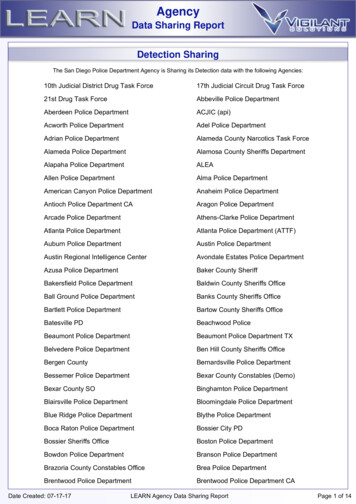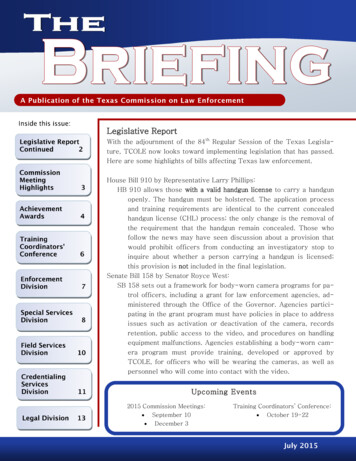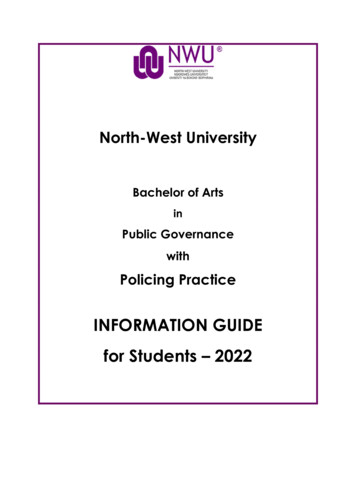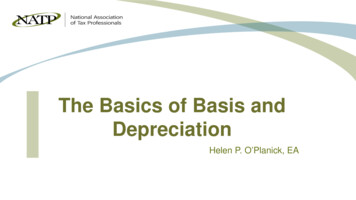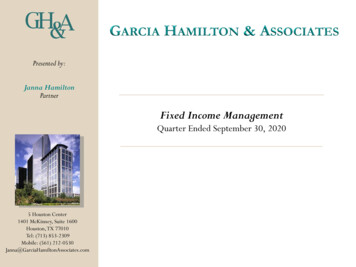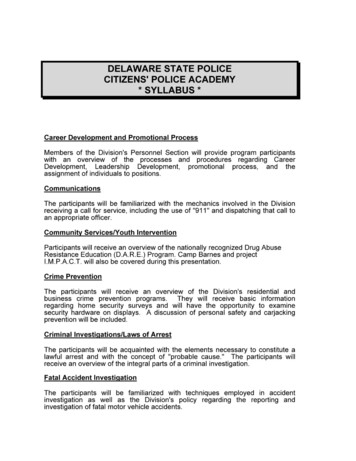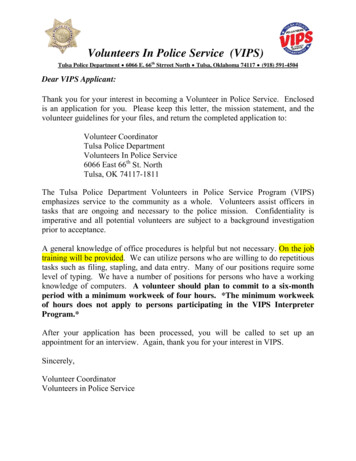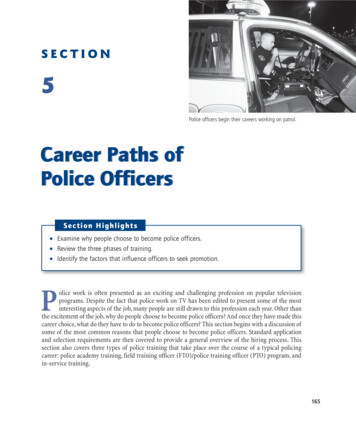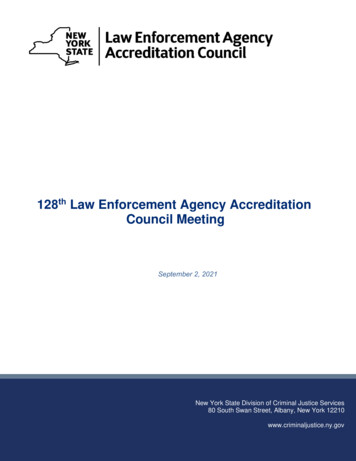
Transcription
—Level 31 / 35 Collins StreetMelbourne Vic 3000T 03 8601 —Police Management of Property and ExhibitsVictorian Auditor -General’s OfficeSeptember 2018Police Managementof Property andExhibitsSeptember 20182018–19: 517775 VAGO Police Management of Property and Exhibits COVER.pdf Page 1 of 1Independent assurance report to Parliament2018–19: 517775 VAGO Police Management of Property and Exhibits COVER.pdf Page 1 of 1
PoliceManagementof Propertyand ExhibitsIndependent assurance report to ParliamentOrdered to be publishedVICTORIAN GOVERNMENT PRINTERSeptember 2018PP no 437, Session 2014–18
This report is printed on Monza Recycled paper. Monza Recycled is certified Carbon Neutral by The Carbon Reduction Institute(CRI) in accordance with the global Greenhouse Gas Protocol and ISO 14040 framework. The Lifecycle Analysis for MonzaRecycled is cradle to grave including Scopes 1, 2 and 3. It has FSC Mix Certification combined with 99% recycled content.ISBN 978 1 925678 31 4
The Hon Bruce Atkinson MLCPresidentLegislative CouncilParliament HouseMelbourneThe Hon Colin Brooks MPSpeakerLegislative AssemblyParliament HouseMelbourneDear Presiding OfficersUnder the provisions of section 16AB of the Audit Act 1994, I transmit my reportPolice Management of Property and Exhibits.Yours faithfullyAndrew GreavesAuditor-General5 September 2018
ContentsAudit overview . 7Conclusion .7Findings.8Recommendations .14Responses to recommendations .151 Audit context . 171.11.21.31.41.51.61.7Property and exhibits .17Roles and responsibilities .25Past reviews and recommendations .26Previous audits .28Why this audit is important .28What this audit examined and how .28Report structure .292 Property management control framework . 312.12.22.32.42.52.62.72.8Conclusion .32Policies and procedures .33Support and training .35Property management system .39Organisational monitoring of compliance .46Property store audits .47Organisational monitoring of occupational health and safety risks .53Transition to a single property capability owner .553 Seizure, storage and disposal . 573.13.23.33.43.5Conclusion .57Test of essentiality .58Storage.62Length of time in police possession and efficiency of disposal .64Transport and Logistics Centre . 72Appendix A. Audit Act 1994 section 16—submissions and comments . 75Appendix B. PEMRP project streams . 79Appendix C. Draft updated process flow for seized items. 81Victorian Auditor‐General’s ReportPolice Management of Property and Exhibits5
Acronyms6FoFfinding of factGVMgreen vegetable matterOHSoccupational health and safetyOPPOffice of Public ProsecutionsPaLMProperty and Laboratory ManagementPEMRPProperty and Exhibit Management Reform ProgramPSCProfessional Standards CommandRTOreturn to ownerSOPStandard Operating ProcedureTALCTransport and Logistics CentreTEABtamper‐evident audit bagVAGOVictorian Auditor‐General’s OfficeVPMVictoria Police ManualWIMWorkplace Inspection ManualPolice Management of Property and ExhibitsVictorian Auditor‐General’s Report
Audit overviewProperty and exhibit management is integral to policing and critical to successfulprosecutions. While managing property and exhibits is primarily a clericalfunction, mismanagement can pose risks to the administration of justice andcan impact the community’s perception of police integrity.An exhibit is any propertyin police possession thatmay be tendered in courtas evidence.Police collect a vast range of property in the course of their duties,encompassing all lost and found, created, surrendered and seized propertythat comes into their possession. Victoria Police records show approximately470 000 items in police possession as at June 2018, stored at more than200 locations, including police stations, central storage locations, CrimeCommand and the Victoria Police Forensic Services Centre.Victoria Police uses its Property and Laboratory Management (PaLM) systemto document the description and life cycle of property. This includes when theproperty comes into police possession, any movements and forensic analysisconducted, and the nature and circumstances surrounding its disposal.Victoria Police has recently completed an improvement project, the Propertyand Exhibit Management Reform Program (PEMRP). The PEMRP aimed toimprove accountability and governance, integrate legislation, create processefficiencies and reduce risks associated with property management.In this audit, we examined whether Victoria Police stores and secures propertyand exhibits effectively and efficiently. In doing so, we considered whetherVictoria Police has a control framework for the management of property andexhibits that supports high performance by clearly articulating expectations andinternal accountabilities and which enables effective organisational oversightof the function. We also examined whether Victoria Police stores and securesproperty in a way that supports frontline staff, reduces associated risks such asoccupational health and safety (OHS) risks and maintains evidentiary value, andhow improvement projects for property management are prioritised andsustained.ConclusionVictoria Police holds on to more property than necessary. It cannot be confidentthat property is kept to a minimum based on its evidentiary value; that itshandling and storage is safe and secure; or that its disposal is timely.This puts strain on staff workloads and storage facilities, and exacerbatesproblems associated with security and disposal. The volume of propertyand exhibits, when combined with ineffective systems and processes usedto manage them, results in additional avoidable costs for storage andadministration and, at times, keeps police members away from their primaryoperational duties.Victorian Auditor‐General’s ReportPolice Management of Property and Exhibits7
The root cause of this inefficiency is a weak control framework for the propertymanagement function. While most individual property officers and policemembers show a genuine commitment to the safe and appropriate handlingand management of property at a worksite level, inconsistent and inefficientorganisational arrangements do not ensure a consistently high‐performingproperty management function.While we did not find any evidence that these issues are producing adverseoutcomes in investigative or judicial proceedings, inefficient property practicesand procedures across Victoria Police are costing more than they should.Victoria Police’s recent concerted effort to implement improvement projectshas addressed some important issues, but significant gaps remain. Theappointment of the Operational Infrastructure Department as the new propertyand exhibits capability owner is an important first step to providing strategicleadership and active oversight for this diverse function. However, much workstill needs to be completed to ensure that Victoria Police can maintain themomentum of the recent reform initiatives and that the role of the capabilityowner encompasses all essential aspects of property and exhibits management.FindingsProperty management control frameworkHistorically, Victoria Police has not had a single point of accountability toprovide strategic direction and oversight of this important function. This hasresulted in practices and procedures that are inconsistent across theorganisation, and administrative inefficiencies: Training and support services are not consistent or always available, leadingto inconsistencies in practices. The property management IT system is not fit for purpose and impedes,rather than facilitates, efficient property management. Reporting and oversight arrangements are ineffective and do not provide anorganisational view of all property holdings. While there are systems to identify and manage individual property‐relatedOHS risks and associated claims, Victoria Police does not know the volumeand extent of these risks or property‐related OHS claims across theorganisation.Victoria Police recently established a single organisational owner for theproperty and exhibit management function, with the Operational InfrastructureDepartment taking responsibility from 1 July 2018. However, Victoria Police hasyet to clearly define the management and oversight responsibilities of this role.8Police Management of Property and ExhibitsVictorian Auditor‐General’s Report
The new property capability owner will need to address all essential aspects ofthe property management function and receive funding and resources to allowthis to happen. While day‐to‐day property and exhibit management remains atthe station or business unit level and divisions/regions remain accountable formanaging property under their control, an effective capability owner will needto: monitor coordinated reporting from the divisional and regional/departmentlevel to oversee compliance and to identify trends and strategically managethe property management function develop and update policies and procedures develop and disseminate comprehensive training enforce stocktake audit requirements and monitor the outcomes monitor organisational risks, such as OHS risks manage the property management system, ensuring it is fit for purpose andupholds data integrity prioritise and oversee improvement projects.Policies, procedures and trainingThe property officer isresponsible for day‐to‐dayproperty functions,including lodging receivedproperty, updatingdatabases, and organisingdisposal once approved.The informant is theinvestigating policemember. The informantis responsible for theproperty he or she hascollected.The officer in chargeof each work unit isresponsible for managingtheir members’ property.For example, ensuringproperty collected isonly that required forevidentiary purposes andthat property is disposedwithin timelines.Victorian Auditor‐General’s ReportVictoria Police does not have comprehensive policies and guidelines to underpinand support property management. The Victoria Police Manual (VPM) and localStandard Operating Procedures (SOP) do not provide comprehensive advice andguidance for the day‐to‐day management of this function. There are no otherformal guidance documents or a central contact within Victoria Police for staffto seek clarification or support.This, combined with a lack of formal property management training, has meantthat property officers and police members have mainly relied on informaltraining opportunities. This has resulted in inconsistent practices for propertymanagement and some noncompliance with policy requirements. For example,there are large variations in the way property is recorded within PaLM that canmake it difficult to analyse data. Also, a property officer from one of the eightstations we visited was not aware of the property store audit requirements,despite being in the role for over two years. Lack of auditing increases the riskthat property may go missing or be recorded incorrectly.Victoria Police released a new e‐learning training course on propertymanagement in January 2018. The training provides a good foundation butdoes not currently address all training and skill gaps. To provide support forall police ranks and staff roles, the training requires additional modules, such asthose for informants or the officers in charge, however resources and fundinghave not been committed to develop these.Police Management of Property and Exhibits9
Property management systemThe PaLM IT system has many usability and functionality issues and does notsupport the business needs of Victoria Police. These issues create considerableadditional work, which could be better spent on operational policing or on otheraspects of managing property. Overall, the system’s reputation among policemembers and property officers is not good, and it is seen as a barrier todischarging their property management obligations rather than an aid.PaLM is slow, with lengthy, convoluted and non‐intuitive processes for recordingproperty. There are also limited data quality controls, such as mandatory fields,which would help drive consistency of recording.Further, the reporting function is not fit for purpose and does not allow policeto generate simple monitoring reports. However, of greater concern is that itdoes not produce reliable compliance reporting.Victoria Police is in the process of developing a PaLM dashboard that willproduce more valuable and effective business reports, with the aim of: streamlining property destructions by holding stations and informants toaccount providing more accurate compliance indicators.This is a big step forward. However, as the data for the dashboard will be pulledfrom PaLM, underlying issues with the integrity of the data are still likely toresult in inaccurate reporting.Organisational monitoring and reportingProperty management compliance reports from PaLM do not provide anaccurate view of compliance. This leads to several issues, including a lack ofunderstanding of the actual performance of the property management functionat a station level. It also means officers in charge need to manually review everyreported compliance issue each month, which is time consuming and competeswith operational policing demands.There is a strong focus on compliance at a station level, however this canbe counterproductive as the compliance reports do not provide valuableinformation. Compliance is displayed using a traffic light system and policemembers advised us that management ‘doesn’t want to see red’, whichindicates noncompliance. This has led to staff manipulating the gauges tocorrect the PaLM data to show greater compliance. However, a ‘green’ ratingon the compliance report may provide false comfort if the compliance modelitself is not accurate.10Police Management of Property and ExhibitsVictorian Auditor‐General’s Report
A brief of evidence (brief)is a compilation of alldocuments relevant tothe prosecution of a case.Briefs are assigned anumber, the brief booknumber, which should belinked to the PaLM recordfor property items thathave evidentiary valuein that case.The focus on achieving compliance, coupled with existing system limitationsin how property can be recorded, has created conditions that prompt policemembers to use workarounds. For example, one noncompliance category iswhen items are in possession for three months or more without a brief booknumber. While there are legitimate instances where this can occur, such aswhen there has been no offender or suspect identified, PaLM does not havethe ability to identify these items and take them off the noncompliance list.Therefore, some officers insert ‘dummy’ brief book numbers so that they arenot inappropriately flagged as compliance issues. While members use thisworkaround because of frustration with the system, tolerating a culture wheremembers may feel free to alter or inaccurately record details for a variety ofreasons weakens the control framework. This is especially concerning for a lawenforcement agency.Above the station level, there are no clear lines of accountability and reportingthrough the divisional or regional levels to a central point within theorganisation. This limits Victoria Police’s ability to understand the performanceof its property management function across the organisation and for it toidentify any organisation‐wide matters that it needs to improve.Failure to effectively manage property exposes individuals to multiple OHSrisks—for example, handling dangerous items or hazardous materials suchas cannabis, other drugs or firearms and weapons. While Victoria Police hassystems to identify and manage individual OHS risks and associated claims, itcannot readily identify the volume or trends of OHS claims specifically causedby activities related to property management . The lack of organisation‐widemonitoring limits Victoria Police’s ability to identify any common and systemicrisks to staff and to act accordingly to mitigate them.Victoria Police’s practices for auditing property stores also vary, with moststations and storage locations not fulfilling the required four full audits a year.Our data analysis showed that four locations had not audited any of theirproperty items in 2017, and a further 12 locations had only audited between1 and 5 per cent of their items in 2017. There is no organisational oversightto hold work units to account for not following up audit issues or for notcompleting the required property store audits. This increases the risk thatVictoria Police does not have an accurate record of property holdings and thatinappropriate handling or treatment of property and exhibits is not detected.Victorian Auditor‐General’s ReportPolice Management of Property and Exhibits11
Seizure, storage and disposal of propertyTest of essentiality and use of secondary evidenceThe test of essentialitymeans that items shouldbe retained only ifrequired for evidentiarypurposes and if secondaryevidence cannot be used.Secondary evidence is acopy, replica or substitutefor primary evidence. Forexample, a photocopy,photo or video recording.The test of essentiality seeks to prevent police members from seizingunnecessary exhibits and to encourage the use of secondary evidence wherepossible. Robust application of the test of essentiality to property managementwill reduce property holdings and potentially minimise other risks, such asmanual‐handling injuries. However, completion of the test is not documented,meaning there is no way to know whether the test is consistently applied whenseizing property.Victoria Police is also not making best use of secondary evidence to achievestorage and process efficiencies. While there are serious constraints on the useof secondary evidence, incremental improvements are possible.For example, police officers, particularly investigators, described a strongdisposition to err on the side of collecting and retaining physical items, as itis hard for them to judge at the time of initial seizure whether items will besignificant to a case. While this is understandable, it highlights the importanceof periodic reviews of the evidentiary value of property.Another constraint is that the failure to produce primary evidence or make itavailable to the defence could result in a miscarriage of justice. While secondaryevidence can create efficiencies, agreement will need to be sought with theOffice of Public Prosecutions (OPP) and Victoria Police Prosecutions aboutwhen and how secondary evidence is used for exhibits relating to seriouscrimes. Nevertheless, there is opportunity to maximise the use of secondaryevidence for low‐risk property types, such as car registration plates.StorageVictoria Police must retain exhibits from unsolved serious crimes for a minimumof 50 years—but it does not know how many items in its possession are subjectto this rule. This creates a risk that Victoria Police is not storing items correctlyto maintain their evidentiary value and that it will not be able to strategicallyforecast capacity requirements for these items in the future.We identified significant gaps in Victoria Police’s handling and storage of allproperty types. Policies and procedures do not set clear standards to ensurethat all items are stored safely and securely and protected from contaminationor degradation. We observed risks to the integrity of property, such as hightemperatures or leaking roofs, in some property stores.12Police Management of Property and ExhibitsVictorian Auditor‐General’s Report
Victoria Police is attempting to address gaps in its policies and processes byestablishing storage requirements through several PEMRP projects and throughupdates to the VPM. These confirm some minimum standards for storagefacilities and define ‘serious unsolved crime’. However, significant gaps remain,such as not requiring the creation of secondary evidence for all items moved tolong‐term storage and not assessing locations against known risks that mayimpact property’s evidentiary value.DisposalThe efficient and timely disposal of property is the responsibility of theinformant managing the property. However, time pressure and processinefficiencies often prevent informants from actively managing the propertythey have collected, resulting in disposal being delayed indefinitely oroverlooked altogether.For property and exhibits already in storage, there is no programmed reviewto reapply the test of essentiality—including property currently in possessionrelated to long‐term serious unsolved crimes. Therefore, Victoria Police cannotbe confident that the number of property items is being kept to a minimum andthat they are retained based on their evidentiary value.In a recent and successful pilot approach, secondary evidence allowed VictoriaPolice to destroy over 40 000 cannabis plants weighing over 18 tonnes—whichis more than six times what could be destroyed during a similar period using atraditional approach. In addition to creating storage efficiencies, this alsosignificantly reduced OHS risks related to this property. The pilot approach wasrecently approved to become business as usual.Transport and Logistics CentreVictoria Police has developed a proposal for the construction of a Transport andLogistics Centre (TALC). TALC would be a fit‐for‐purpose central warehouse withaccess to facilities and technologies to improve the management of records,equipment and property. Victoria Police forecasts that TALC would return asurplus to the state, due to revenue from the sale of existing sites, and benefitthe organisation through minimising the time police spend transportingproperty. The TALC proposal has not yet been funded, and Victoria Police’sOperational Infrastructure Department does not currently have plans toimplement the identified transport efficiencies outside of the TALC concept.Victorian Auditor‐General’s ReportPolice Management of Property and Exhibits13
RecommendationsWe recommend that Victoria Police:1. define the expectations and responsibilities of a property capability ownerto ensure that the property management function aligns with the strategicdirection of the organisation, including: monitoring coordinated reporting from the divisional andregional/department levels to oversee compliance, identify trends andstrategically manage the property management function developing and disseminating comprehensive training for policemembers and property officers and continuing to implement thecommunity of practice for property officers developing and updating policies and procedures ensuring the integrity of data captured in PaLM prioritising and overseeing improvement projects ensuring adequate conditions for warehousing and infrastructure(see Part 2)2. develop an end‐to‐end property management handbook (see Section 2.2)3. encourage all existing and new staff with operational or administrativeproperty responsibilities to undertake the property management e‐learningtraining (see Section 2.3)4. improve or replace the current property management IT system so that it isfit for purpose in supporting frontline staff and reporting requirements(see Sections 2.4 and 2.5)5. implement a standardised stocktake audit schedule that is based on thelevel of assurance that Victoria Police requires for effective propertymanagement and: ensures baseline safety and OHS requirements are met ensures the evidentiary value of property and exhibits is maintained ensures risks associated with ageing infrastructure are identified andaddressed is adequately supported with audit tools and technology improves assurance processes through the enforcement andmonitoring of stocktake audit outcomes (see Sections 2.6 and 3.3)6. consult with Victoria Police Prosecutions, the Victoria Police ForensicServices Centre and the Office of Public Prosecutions to identify and assessopportunities to increase the use of secondary evidence (see Section 3.2)7. assess how much property related to unsolved serious crimes is currently inpolice possession and forecast future storage capacity and packaging needsfor all items that fall under the 50‐year retention rule (see Section 3.3)8. consider alternative methods to implement the potential efficienciesfor property transportation, identified through the TALC proposal(see Section 3.5).14Police Management of Property and ExhibitsVictorian Auditor‐General’s Report
Responses torecommendationsWe have consulted with Victoria Police throughout the audit and we consideredits views when reaching our audit conclusions. As required by section 16(3)of the Audit Act 1994, we gave a draft copy of this report to Victoria Police andasked for its submissions or comments. We also provided a copy of the report tothe Department of Premier and Cabinet.The following is a summary of Victoria Police’s response. The full response isincluded in Appendix A.Victoria Police accepted seven recommendations in full, noting they haveresourcing and investment implications, and one recommendation in principle.Victoria Police has provided an action plan that addresses all recommendations.In its response, Victoria Police noted that while some processes can beimproved, they have longstanding policies and guidelines that have supportednumerous investigations and judicial proceedings.Victorian Auditor‐General’s ReportPolice Management of Property and Exhibits15
Audit context1.1 Propertyand exhibitsProperty classesVictoria Police collects a vast range of property in the course of its duties.Managing this property is an integral part of policing and a critical part ofsuccessful prosecutions to maintain community safety.Property includes all lost and found, created, surrendered and/or seizedproperty that comes into police possession. The property’s class is determinedby how the item has come into police possession. An exhibit is any property inpolice possession that may be used in court as evidence.Figure 1A defines the four property classes.Figure 1AThe four property classesFoundLost or abandonedproperty that hasbeen found andhanded in to police.SeizedCreatedItems collected,confiscated or seizedas part of aninvestigation. Itemsare seized from acrime scene, personor location underthe authority of awarrant or law.Items that havebeen created byVictoria PoliceForensic ServicesCentre staff for thepurpose of forensicexamination.SurrenderedProperty that hasbeen voluntarily orinvoluntarilyrelinquished to policesuch as firearmssurrendered in anamnesty or thesurrendering of apassport.Source: VAGO based on information provided by Victoria Police.Victorian Auditor‐General’s ReportPolice Management of Property and Exhibits17
In this audit, we focus on the collection, management and disposal of seizedproperty and exhibits. Of the property currently in police possession, seizedproperty accounts for the largest amount (78 per cent), followed by createdproperty (14 per cent), as shown in Figure 1B.Figure 1BPercentage of property in police possession by class2% 6%14%FoundSeizedCreatedSurrendered78%Source: VAGO based on PaLM data, extracted 20 June 2018.Types of seized propertyBuccal swabs are
Police Management of Property and Exhibits 2018-19: 5 September 2018 Independent assurance report to Parliament 2018-19: 5 Police Management of Property and Exhibits September 2018 . handling and storage is safe and secure; or that its disposal is timely. This puts strain on staff workloads and storage facilities, and exacerbates .
